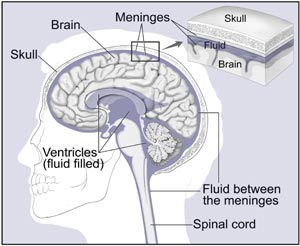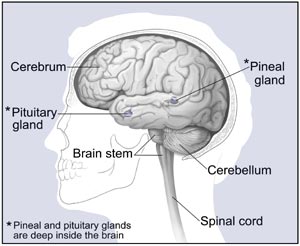Brain Tumor, Adult
Introduction:
This page has important information about brain tumors.* It discusses possible causes, symptoms, diagnosis, treatment, and follow up care. It also has information to help patients cope with brain tumors.
A tumor that begins in the brain is called a primary brain tumor. In children, most brain tumors are primary tumors. In adults, most tumors in the brain have spread there from the lung, breast, or other parts of the body. When this happens, the disease is not brain cancer. The tumor in the brain is a secondary tumor. It is named for the organ or the tissue in which it began.
Treatment for secondary brain tumors depends on where the cancer started and the extent of the disease.
The Brain
The brain is a soft, spongy mass of tissue. It is protected by the bones of the skull and three thin membranes called meninges. Watery fluid called cerebrospinal fluid cushions the brain. This fluid flows through spaces between the meninges and through spaces within the brain called ventricles.
Illustration shows the skull, spinal cord, brain, meninges, ventricles, the fluid between the meninges, and the fluid in the ventricles.
 A network of nerves carries messages back and forth between the brain and the rest of the body. Some nerves go directly from the brain to the eyes, ears, and other parts of the head. Other nerves run through the spinal cord to connect the brain with the other parts of the body. Within the brain and spinal cord, glial cells surround nerve cells and hold them in place.
A network of nerves carries messages back and forth between the brain and the rest of the body. Some nerves go directly from the brain to the eyes, ears, and other parts of the head. Other nerves run through the spinal cord to connect the brain with the other parts of the body. Within the brain and spinal cord, glial cells surround nerve cells and hold them in place.
The brain directs the things we choose to do (like walking and talking) and the things our body does without thinking (like breathing). The brain is also in charge of our senses (sight, hearing, touch, taste, and smell), memory, emotions, and personality.
The three major parts of the brain control different activities:- Cerebrum — The cerebrum is the largest part of the brain. It is at the top of the brain. It uses information from our senses to tell us what is going on around us and tells our body how to respond. It controls reading, thinking, learning, speech, and emotions.
The cerebrum is divided into the left and right cerebral hemispheres, which control separate activities. The right hemisphere controls the muscles on the left side of the body. The left hemisphere controls the muscles on the right side of the body.
- Cerebellum — The cerebellum is under the cerebrum at the back of the brain. The cerebellum controls balance and complex actions like walking and talking.
- Brain Stem — The brain stem connects the brain with the spinal cord. It controls hunger and thirst. It also controls breathing, body temperature, blood pressure, and other basic body functions.

Understanding Cancer
Cancer begins in cells, the building blocks that make up tissues. Tissues make up the organs of the body.
Normally, cells grow and divide to form new cells as the body needs them. When cells grow old, they die, and new cells take their place.
Sometimes this orderly process goes wrong. New cells form when the body does not need them, and old cells do not die when they should. These extra cells can form a mass of tissue called a growth or tumor.
Benign and Malignant Brain TumorsBrain tumors can be benign or malignant:
- Benign brain tumors do not contain cancer cells:
- The border or edge of a benign brain tumor can be clearly seen. Cells from benign tumors do not invade tissues around them or spread to other parts of the body. However, benign tumors can press on sensitive areas of the brain and cause serious health problems.
- Unlike benign tumors in most other parts of the body, benign brain tumors are sometimes life threatening.
- Very rarely, a benign brain tumor may become malignant.
- Malignant brain tumors contain cancer cells:
- Malignant brain tumors are generally more serious and often are life threatening.
- They are likely to grow rapidly and crowd or invade the surrounding healthy brain tissue.
- Very rarely, cancer cells may break away from a malignant brain tumor and spread to other parts of the brain, to the spinal cord, or even to other parts of the body. The spread of cancer is called metastasis.
- Sometimes, a malignant tumor does not extend into healthy tissue. The tumor may be contained within a layer of tissue. Or the bones of the skull or another structure in the head may confine it. This kind of tumor is called encapsulated
Tumor Grade
Doctors sometimes group brain tumors by grade—from low grade (grade I) to high grade (grade IV). The grade of a tumor refers to the way the cells look under a microscope. Cells from high-grade tumors look more abnormal and generally grow faster than cells from low-grade tumors.
Primary Brain Tumors
Tumors that begin in brain tissue are known as primary tumors of the brain. (Information about secondary brain tumors appears in the following section.) Primary brain tumors are named according to the type of cells or the part of the brain in which they begin.
The most common primary brain tumors are gliomas. They begin in glial cells. There are many types of gliomas:
- Astrocytomas — The tumor arises from star-shaped glial cells called astrocytes. In adults, astrocytomas most often arise in the cerebrum. In children, they occur in the brain stem, the cerebrum, and the cerebellum. A grade III astrocytoma is sometimes called an anaplastic astrocytomas. A grade IV astrocytoma is usually called a glioblastoma multiforme.
- Brain stem glioma — The tumor occurs in the lowest part of the brain. Brain stem gliomas most often are diagnosed in young children and middle-aged adults.
- Ependymoma — The tumor arises from cells that line the ventricles or the central canal of the spinal cord. They are most commonly found in children and young adults.
- Oligodendroglioma — This rare tumor arises from cells that make the fatty substance that covers and protects nerves. These tumors usually occur in the cerebrum. They grow slowly and usually do not spread into surrounding brain tissue. They are most common in middle-aged adults
Some types of brain tumors do not begin in glial cells. The most common of these are:
- Medulloblastoma — This tumor usually arises in the cerebellum. It is the most common brain tumor in children. It is sometimes called a primitive neuroectodermal tumor.
- Meningioma — This tumor arises in the meninges. It usually grows slowly.
- Schwannoma — A tumor that arises from a Schwann cell. These cells line the nerve that controls balance and hearing. This nerve is in the inner ear. The tumor is also called an acoustic neuroma. It occurs most often in adults.
- Craniopharyngioma — The tumor grows at the base of the brain, near the pituitary gland. This type of tumor most often occurs in children.
- Germ cell tumor of the brain — The tumor arises from a germ cell. Most germ cell tumors that arise in the brain occur in people younger than 30. The most common type of germ cell tumor of the brain is a germinoma.
- Pineal region tumor — This rare brain tumor arises in or near the pineal gland. The pineal gland is located between the cerebrum and the cerebellum
Secondary Brain Tumors
When cancer spreads from its original place to another part of the body, the new tumor has the same kind of abnormal cells and the same name as the primary tumor. Cancer that spreads to the brain from another part of the body is different from a primary brain tumor. When cancer cells spread to the brain from another organ (such as the lung or breast), doctors may call the tumor in the brain a secondary tumor or metastatic tumor. Secondary tumors in the brain are far more common than primary brain tumors
Brain Tumors: Who's at Risk?
No one knows the exact causes of brain tumors. Doctors can seldom explain why one person develops a brain tumor and another does not. However, it is clear that brain tumors are not contagious. No one can "catch" the disease from another person.
Research has shown that people with certain risk factors are more likely than others to develop a brain tumor. A risk factor is anything that increases a person's chance of developing a disease.
The following risk factors are associated with an increased chance of developing a primary brain tumor:
- Being male — In general, brain tumors are more common in males than females. However, meningiomas are more common in females.
- Race — Brain tumors occur more often among white people than among people of other races.
- Age — Most brain tumors are detected in people who are 70 years old or older. However, brain tumors are the second most common cancer in children. (Leukemia is the most common childhood cancer.) Brain tumors are more common in children younger than 8 years old than in older children.
- Family history — People with family members who have gliomas may be more likely to develop this disease.
- Being exposed to radiation or certain chemicals at work:
- Radiation — Workers in the nuclear industry have an increased risk of developing a brain tumor.
- Formaldehyde — Pathologists and embalmers who work with formaldehyde have an increased risk of developing brain cancer. Scientists have not found an increased risk of brain cancer among other types of workers exposed to formaldehyde.
- Vinyl chloride — Workers who make plastics may be exposed to vinyl chloride. This chemical may increase the risk of brain tumors.
- Acrylonitrile — People who make textiles and plastics may be exposed to acrylonitrile. This exposure may increase the risk of brain cancer.
Scientists are investigating whether cell phones may cause brain tumors. Studies thus far have not found an increased risk of brain tumors among people who use cell phones.
Scientists also continue to study whether head injuries are a risk factor for brain tumors. So far, these studies have not found an increased risk among people who have had head injuries.
Most people who have known risk factors do not get brain cancer. On the other hand, many who do get the disease have none of these risk factors. People who think they may be at risk should discuss this concern with their doctor. The doctor may be able to suggest ways to reduce the risk and can plan an appropriate schedule for checkups
Symptoms
The symptoms of brain tumors depend on tumor size, type, and location. Symptoms may be caused when a tumor presses on a nerve or damages a certain area of the brain. They also may be caused when the brain swells or fluid builds up within the skull.
These are the most common symptoms of brain tumors:- Headaches (usually worse in the morning)
- Nausea or vomiting
- Changes in speech, vision, or hearing
- Problems balancing or walking
- Changes in mood, personality, or ability to concentrate
- Problems with memory
- Muscle jerking or twitching (seizures or convulsions)
- Numbness or tingling in the arms or legs
These symptoms are not sure signs of a brain tumor. Other conditions also could cause these problems. Anyone with these symptoms should see a doctor as soon as possible. Only a doctor can diagnose and treat the problem.





































